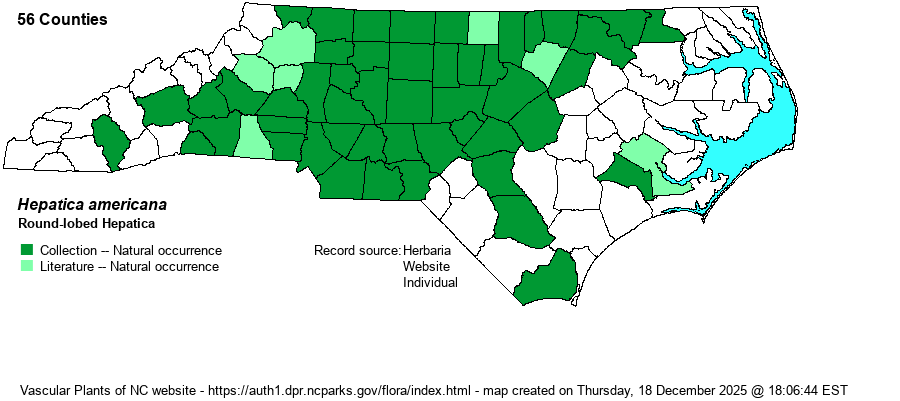| Author | (de Candolle) Ker-Gawler | |
| Distribution | Throughout the Piedmont, and into the western and central Coastal Plain but mainly along brownwater river floodplains. Barely ranges westward into the Mountains, where there are specimens from just three counties.
This species ranges from southeastern Canada south to the FL Panhandle and AR.
| |
| Abundance | Common across the Piedmont. Infrequent in the northwestern Coastal Plain, mainly along the Roanoke River; uncommon along the Cape Fear River southward into Cumberland and Bladen counties, but very rare elsewhere in the province; absent in many counties. Rare in the lower Mountains, mainly close to the Blue Ridge Escarpment. Surprisingly no specimens in the far southwestern counties. | |
| Habitat | This is a species of moist or rich forests, usually on slopes but at times into bottomland forests. It is most often found in Mesic Mixed Hardwood Forests, but it can be found in other forest types. Unlike H. acutiloba, which strongly favors high pH soils, this species grows on somewhat acidic soils, though still where moist and somewhat "rich". |
| Phenology | One of the earliest blooming species of the forest floor, generally from February into April; fruits shortly after flowering. | |
| Identification | This is one of the few "evergreen" species of Ranunculaceae. It is a low-growing herbaceous species, only reaching about 6 inches tall. The several basal leaves are 3-lobed (connected at the base), each lobe being strongly rounded, with convex sides; H. acutiloba has rhombic to triangular lobes that are straight sided and meet at a fairly sharp tip. Each leaf is about 2 inches wide and long. These leaves remain through the winter, but new leaves and the flowering stalks emerge in late winter. The bare flowering stalk grows several inches tall and bears a single flower, though there are typically several such flowering stems per plant. The flower consists of 5-12, usually 5-6, sepals, colored lavender-blue to (rarely) whitish, and about 1 inch wide. In this species, the bracts are rounded and seldom show as viewed from above, whereas in the very similar H. acutiloba, often considered as the same species, the sepals are acute and are often visible when viewing the flower from above. In general, H. acutiloba flowers average a bit paler in color, often more whitish, than are those of H. americana, which are more consistently blue-lavender in color. There are usually just 5-6 sepals in a flower of H. americana, whereas H. acutiloba often has somewhat more sepals (more than 6) on the flowers. Each of these species is a "harbinger of spring", often being one of the first few spring wildflowers an observer notices in late winter -- along with Dimpled Trout-lily (Erythronium umbilicatum), spring-beauty (Claytonia spp.), and a few others. | |
| Taxonomic Comments | These two species seem to be treated differently in each reference in the 21st Century! Weakley (2018) gives reasons for keeping these two with the same names as most references in the mid-20th Century, including RAB (1968). NatureServe lumps both into H. nobilis, and naming this one as H. nobilis var. obtusa. Others put both species or taxa into the genus Anemone, in this case A. americana.
| |
| Other Common Name(s) | Round-lobed Liverleaf, Roundleaf Liverleaf, Roundleaf Hepatica | |
| State Rank | S5 | |
| Global Rank | G5 | |
| State Status | | |
| US Status | | |
| USACE-agcp | | |
| USACE-emp | | |

